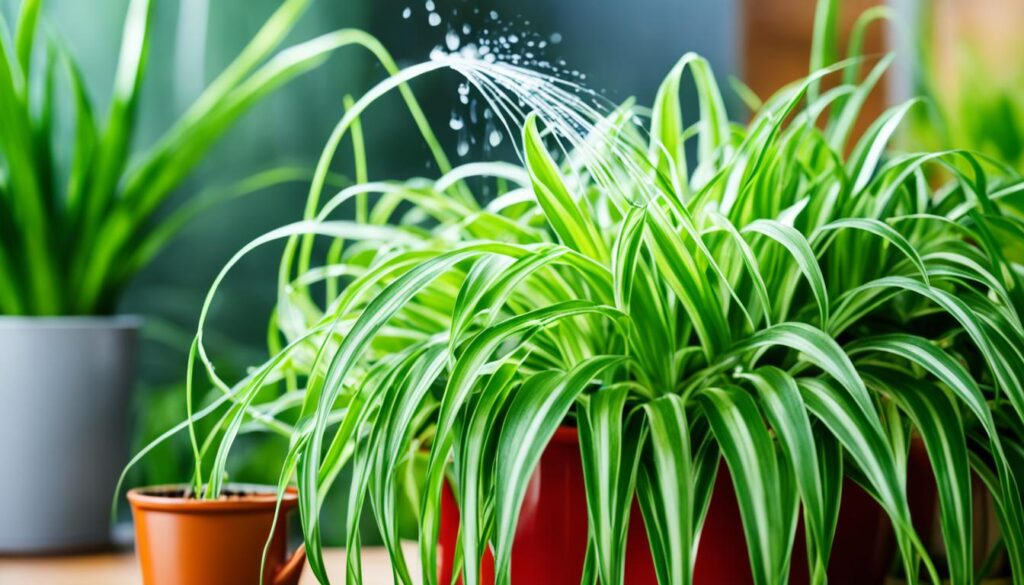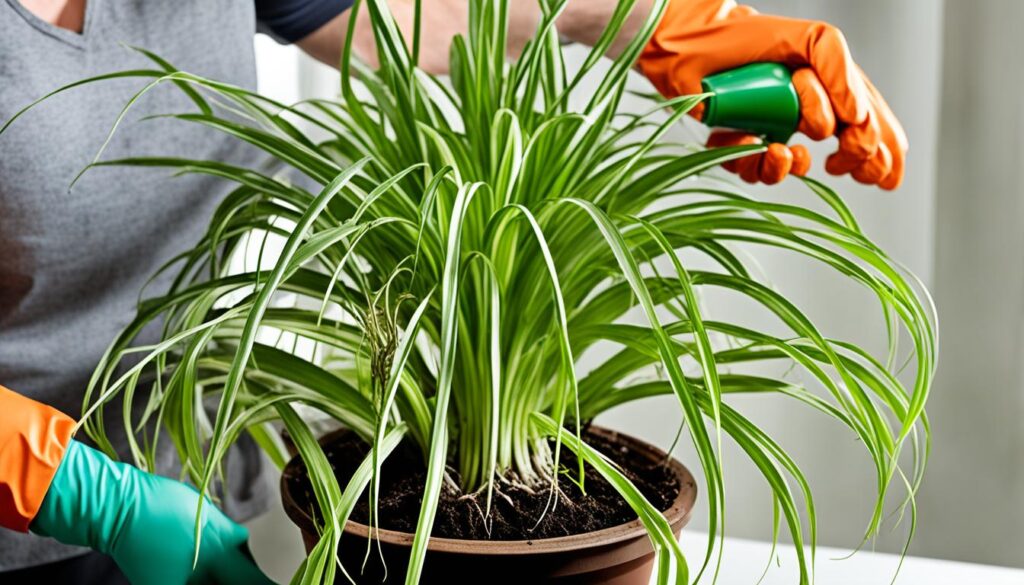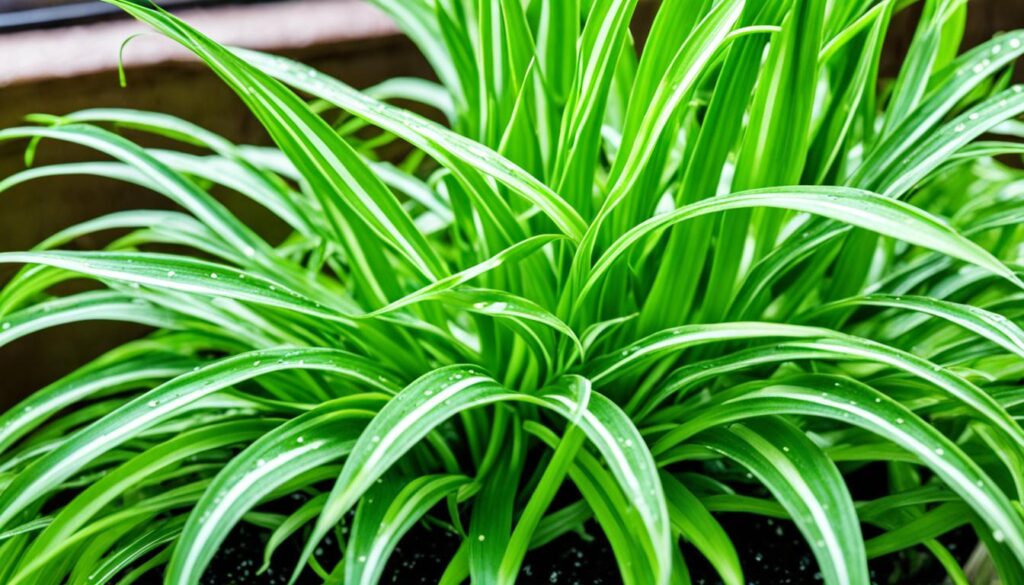Did you know spider plants can grow up to 50cm indoors? They are a classic choice for indoor spaces because they grow fast and don’t take up much room. With the right care, spider plants can do well even in busy homes. They are a favorite among plant lovers and busy people.
This guide is for both new and experienced plant owners. We’ll cover everything from watering and lighting to growing new plants and solving common issues. You’ll learn how to keep your spider plant happy and healthy. Enjoy the lush foliage and beautiful “spiderettes” that make this plant special.
Key Takeaways
- Spider plants are low-maintenance and can thrive on a little neglect
- They grow up to 50cm in size and prefer indirect sunlight
- Proper watering, fertilizing, and repotting are key to keeping your spider plant healthy
- Spider plants are non-toxic and safe for homes with pets or children
- Propagating spider plant pups is an easy way to expand your indoor garden
About Spider Plants
Botanical Classification and Origins
The spider plant, known as Chlorophytum comosum, is a popular houseplant. It’s loved for its long, flowing leaves. These leaves can be solid green or have yellow or white stripes.
Spider plants can grow big in the wild but usually stay small indoors, up to 50cm tall. This depends on how much light they get and the size of their pot.
They come from the tropical and southern parts of Africa. Spider plants are known for being tough and easy to care for. They are part of the Asparagaceae family, which also includes spider ivy and ribbon plant. Some people call them airplane plant or hen and chickens.
“The spider plant is a resilient and low-maintenance houseplant that can thrive even in less-than-ideal conditions.”
The spider plant is known for its beauty and easy care. It’s a favorite in homes and offices worldwide.
Why Spider Plants Are So Easy to Care For
Spider plants are known for being super easy and hard to kill. They are loved by many for their toughness and simple care. Whether you’re a pro at gardening or just starting, spider plants are a great pick for your home.
These plants can grow well in many lighting conditions, from bright sunlight to shady spots. They also handle drought well, needing water only every 10-14 days, based on your home’s warmth and light.
Spider plants are safe for homes with pets and kids because they’re not toxic. This makes them perfect for families and pet owners who want plants but worry about safety.
Spider plants are also great at cleaning the air. They remove harmful toxins like formaldehyde, making your home healthier. With their beautiful leaves and air-purifying power, they’re a smart choice for easy houseplants.
“Spider plants are the ultimate low-maintenance houseplants. They’re virtually unkillable and provide a touch of nature to any indoor space.”
For both plant experts and beginners, spider plants are an excellent choice. They’re easy to care for, safe for pets, and clean the air. Their toughness and flexibility make them a favorite among low maintenance houseplants and unkillable plants fans.

Propagating Spider Plants
Spider plants are known for their easy way to make new plants from their “spiderettes”. These are the small baby plants that grow on long stems. This method lets spider plant lovers grow more plants with little work.
How to Propagate Spider Plant Spiderettes
To start a new spider plant, it’s easy. Just take a spiderette and a few roots, and put them in moist soil. Or, you can put the spiderette in water for 1-2 weeks to grow roots before moving it to soil.
Using distilled water is key when propagating spider plants in water. They don’t like the fluoride in tap water. Roots from water can start showing in 7-10 days, but this method might not always work well in soil.
Putting spider plants directly in soil is the fastest and easiest way to grow new plants. The spiderettes will grow roots better in soil, leading to healthier plants.
“Spider plants love some moisture in the air, so misting the baby plant can help boost the humidity level and support its growth.”
When the spiderette has strong roots, you can move it to its own pot. Growing several spider plant babies together can make a thick, full plant. Make sure to water them, keep the soil a bit moist, and give them the right light and food for them to grow well.
You can propagate spider plants all year, but spring and summer are best when they’re growing. Spider plants are easy to reproduce, making them a fun way for gardeners to grow more plants with little effort.
Watering Requirements
Getting the watering right is key to caring for your spider plant. These plants need a light drink every week or so. Check if your spider plant needs watering by sticking your finger into the soil up to the second knuckle. If it feels dry, it’s time to water.
In the cooler fall and winter, reduce watering as the spider plant sleeps more. Overwatering can cause root rot, so don’t let the soil get too wet. Wait until the top inch of soil dries out before watering your spider plant again.
Knowing the signs that a spider plant needs water is crucial. Look for drooping leaves or dry tips to see if your plant is thirsty. Yellow leaves or standing water in the pot mean you’re overwatering your spider plant.
“The key to successful spider plant care is to strike the right balance between not underwatering and not overwatering the plant.”
Stick to a consistent watering routine and watch the soil moisture to keep your spider plant happy. Remember, how often to water spider plants can change based on pot size, soil type, and your environment. Be ready to adjust your watering schedule as needed.

The watering requirements for spider plants are simple but important. With attention and care, your spider plant will stay lush, vibrant, and full of spiderettes for years.
Light Requirements
Spider plants are known for being tough and flexible, but they need the right light to really shine. They can handle different light levels, but they do best with bright, indirect light.
For the best growth and color, spider plants need 4 to 6 hours of bright, indirect sunlight daily. Direct sunlight can burn their leaves, causing them to turn ugly colors and grow poorly. So, place your spider plant where it gets plenty of light but not too much sun. Think about putting it on a desk, shelf, or in a hanging planter where it can enjoy the sun safely.
In the winter, when days are shorter, your spider plant might need extra light. A full-spectrum LED or fluorescent bulb 12-24 inches away can help. This will keep your plant healthy and looking good.
“Proper lighting is essential for maintaining the spider plant’s vibrant colors and encouraging lush, healthy growth.”
Outdoor spider plants like partial shade or light dappled sunlight. Too much direct sun can burn their leaves. So, find a spot that gets some sun but also has shade. Move the plant around as the seasons change to make sure it gets the right light all year.
Give your spider plant the right light, and it will keep thriving and looking great. Remember, it’s all about consistency. Keep an eye on your plant’s light needs and adjust things as needed to keep it happy and healthy.
how to take care of spider plants
To keep a spider plant thriving, you need to do more than just water and light it. There are some extra tips to help your plant stay healthy.
Start by cutting off any brown or damaged leaf tips. This keeps your plant looking good and encourages new growth. It’s a simple way to keep your plant looking its best.
Also, misting the leaves lightly and wiping off dust can help. This keeps the leaves clean and stops dust from blocking photosynthesis. It’s an easy way to keep your plant healthy.
When it’s warm, giving your spider plant a bit of liquid fertilizer can be good. It’s not a must, but it helps with growth and makes the leaves look better.
Adding these steps to your spider plant care routine will keep your plant happy. It will also make your home look nicer.

“Proper care and attention can transform a humble spider plant into a lush, vibrant addition to any home.”
For healthy spider plants, balance is key. Make sure to water, light, and feed your plant right. Also, keep it clean and tidy. With a little care, your spider plant will thrive and give you beautiful foliage and offsets for years.
Temperature Preferences
Spider plants are very adaptable when it comes to temperature. They do best in a temperature range of 55-65°F (13-18°C). These plants can handle cooler or warmer temperatures, but extreme heat or cold can stress them out.
To keep your spider plant happy, keep the room’s temperature between 65°F to 85°F (18°C to 29°C). Avoid sudden changes in temperature, as they can harm the plant. Don’t let the temperature drop below 50°F (10°C) or go above 90°F (32°C), as this can slow down growth and cause damage.
In the cooler months, protect your spider plant from cold air. Make sure it’s not near windows or doors that let in cold air. In the warmer months, keep it away from direct sunlight during the day, as it can also stress the plant.
By keeping your spider plant in the right temperature range and maintaining a stable environment, it will grow well and look great. Watch for signs like mushy leaves or brown tips, which mean it might need a change in care.
“The key to keeping a spider plant happy is maintaining a consistent temperature within its preferred range. Avoid sudden changes, and your plant will thrive.”
In summary, the ideal temperature for spider plants is 55-65°F (13-18°C). A comfortable room temperature of 65-85°F (18-29°C) is best. Knowing how much your plant can handle cold and heat helps you create the perfect environment for it to grow.
Fertilizing Tips
Spider plants don’t need much fertilizer but a little boost during warm months helps them grow well. A light dose of balanced, water-soluble liquid fertilizer once a month is enough. This keeps your spider plant happy and healthy.
Providing Nutrients for Optimal Growth
Spider plants like a balanced diet with equal amounts of nitrogen, phosphorus, and potassium. A 20-20-20 ratio works well. Quick-acting water-soluble fertilizers are best for their growth and blooming. Brands like FoxFarm and Maxsea offer good organic options.
Don’t over-fertilize your spider plant to avoid problems like fertilizer burn and brown leaves. Follow the fertilizer instructions closely. This ensures your plant gets the right nutrients without harm.
- Use a balanced, water-soluble liquid fertilizer with an equal N-P-K ratio, such as 20-20-20
- Apply the fertilizer once a month during the growing season
- Avoid over-fertilizing, as this can cause damage to your spider plant
- Organic fertilizers from trusted brands can also be a great option
Give your spider plant the right nutrients for a lush, vibrant look. Proper spider plant fertilizer and feeding spider plants meet their nutrient requirements and keep them healthy.

Common Problems and Solutions
Spider plants are usually tough and don’t often face common houseplant problems. But, they can have a few issues if not taken care of right. Knowing about these problems and how to fix them can help your spider plant stay healthy.
Overwatering and Root Rot
One big issue with spider plants is overwatering, which can cause root rot. To stop this, let the soil dry out a bit between waterings. And make sure the plant isn’t sitting in water.
Leaf Tip Browning
If your spider plant’s leaves start to turn brown at the tips, it’s probably because of too much direct sunlight. Move the plant to a spot with bright, indirect light to stop more damage.
Pest Infestations
Spider plants can get pests like whiteflies, spider mites, scales, and aphids. If you see these pests, use a gentle, insecticidal spray to get rid of them.
“Spider plants have air purifying capabilities and can remove up to 90% of potentially toxic chemicals in the air.” – NASA Research
By fixing these common spider plant diseases, spider plant pests, and other spider plant care issues, your plant can stay healthy and look great. Make sure to water, light, and manage pests correctly to troubleshoot spider plants.
- Regularly check the soil moisture to avoid overwatering.
- Move the plant to a spot with bright, indirect light to prevent leaf tip browning.
- Use a gentle insecticidal spray to control any pest infestations.
By solving these common issues, you can keep your spider plant healthy and happy for many years.
Repotting and Planting
When and How to Repot Spider Plants
Spider plants are tough but need repotting now and then to stay healthy. About 60% of spider plant owners move their plants every 2-3 years for the best growth. It’s best to repot when the roots fill the pot and the plant looks pot-bound.
When it’s time, pick a pot that’s only 1-2 inches wider than the old one. This makes spider plant repotting easier on the plant. Use a potting mix made for houseplants and water the plant well after moving it. This helps the spider plant transplanting roots settle in the new soil, making the move smoother.
Don’t replant spider plants in the cold months when they’re less active. Spring or early summer is the best time for spider plant repotting when they’re growing well.

“Regular repotting is essential for keeping spider plants healthy and thriving. It allows the roots to expand and the plant to continue growing strong.”
Follow these easy steps to keep your spider plant happy and healthy for many years.
Spider Plant Varieties
The spider plant, known as Chlorophytum comosum, comes in many types. These plants are loved for being easy to care for, cleaning the air, and their beautiful leaves. Whether you’re new to gardening or have been doing it for years, there’s a spider plant for you.
The Vittatum variety has pale green leaves with a white stripe in the middle. This adds elegance to any spot. The Variegatum has longer leaves with white edges, making a beautiful contrast. For something bolder, the Milky Way has a wide white center. The Mandaianum is smaller with yellow stripes on dark green leaves.
Some spider plants have more colorful leaves. The Vittatum Bouquet has white and green stripes. The Purple Passion has deep purple leaves, adding drama to any area.
“Spider plants are renowned for their air-purifying abilities, making them a popular choice for offices and homes alike.”
Spider plants also vary in how they grow. The Compactum stays small and bushy. Others, like the Longum, grow taller with longer leaves. This means you can pick the perfect spider plant for your space and style.
Whether you like the classic green-and-white or the unique and bright ones, there’s a spider plant for everyone. By looking at the different types, you can find the perfect one for your home or office. These plants are tough, beautiful, and great for cleaning the air.
Conclusion
The spider plant is a top choice for those new to houseplants. It grows quickly, stays small, and can handle many conditions. With the right care, it will give you lots of baby plants and beautiful leaves for years.
These plants are perfect for beginners because they’re easy to care for. NASA says they clean the air, making them great for indoor spaces. They like bright, indirect sunlight and temperatures between 55 and 80 degrees Fahrenheit.
Spider plants are also pest-resistant and can grow new plants from their “pups.” This makes them a great choice for indoor gardening. By following a few simple care tips, you can keep these plants healthy and beautiful.



Thank you for your sharing. I am worried that I lack creative ideas. It is your article that makes me full of hope. Thank you. But, I have a question, can you help me?